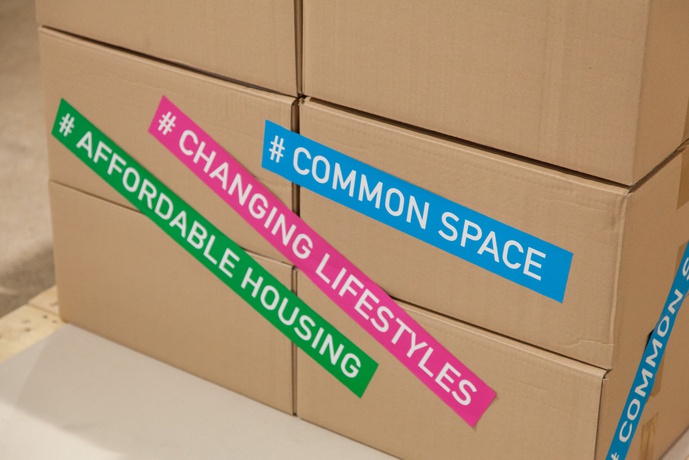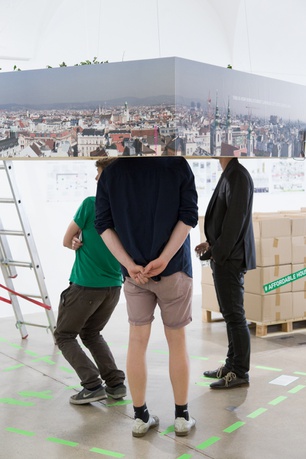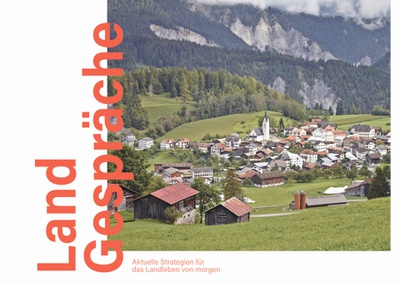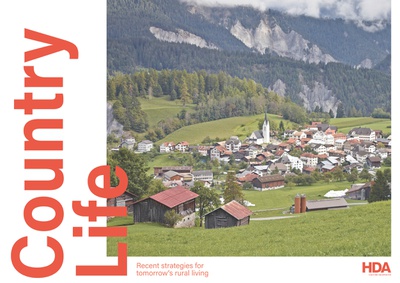Die „LandGespräche“ begleitend zur Ausstellung „LandLeben“ präsentieren in verschiedenen thematischen Panels AkteurInnen beispielhafter Projekte und Strategien aus Österreich und der Welt, die zu einer Neubelebung der ländlichen Gebiete beitragen, um damit zum Vordenken, Nachdenken und Mitmachen anzuregen. Die Panels werden aufgezeichnet und können online nachgeschaut werden.
Future Architecture Platform
Future Architecture Platform, founded in 2015, is the first pan-European platform of architecture museums, festivals and producers, bringing ideas on the future of cities and architecture closer to the wider public.
27 institutions from 23 countries create an individual event program consisting of exhibitions, conferences, lectures, workshops, etc. with young creatives from various disciplines, which have not yet been widely perceived. The focus is on dealing with visions for the future of architecture in Europe. The results are documented and published in books and on the web.
Future Architecture goals:
- Think Future. We highlight the emerging generation of talents in various disciplines and explore and share their ideas about the future of cities and architecture.
- Exchange. 27 organisers from 22 countries are creating a pan-European programme, tour emerging creators and present their ideas at exhibitions, conferences, lectures and workshops, in books and on the web.
- Raise awareness. The platform makes complex issues of architecture comprehensible to everyone, and promotes a more sustainable living environment.
- Build commitment. A Future Architecture European Quality label recognizes organisers who work with aspiring emerging talents and show their commitment to the platform objectives.
The Future Architecture platform introduces and celebrates innovation, experimentation and the ideas of a generation that will design the architecture and build Europe’s cities in the years to come. It promotes European innovation, architecture, culture, knowledge and social capital through a single common platform.
Who can participate?
Interested architects, artists and researchers participate in an open call. The selection is made by the member organizations and a public webvoting.
2016
Nearly 300 projects have been submitted for 2016, and a third of international applicants have been invited to 14 European countries to give lectures, participate in exhibitions or hold workshops. Under the title "Form Follows", the House of Architecture in Graz asked nine young architectural teams and individuals to comment on an exhibition curated by ISSS research & architecture on the topics "affordable living", "lifestyles in transition" and "shared spaces". Accompanied by several discourse events, an intensive discourse and a sustainable networking emerged between the international and national exhibition participants as well as the audience.
2017
For 2017, 337 ideas from 594 authors from 56 countries were generated by the Call for Projects. In February 2017, the 25 most interesting projects were presented at the so-called Matchmaking Conference at the Museum of Architecture and Design in Ljubljana. As part of the activities of the Future Architecture Platform in the summer of 2017, the Haus der Architektur presented an exhibition curated by Ana Jeinic, as well as a related symposium.
2018
In 2018, 212 ideas from 492 creatives from 43 countries were submitted to the Open Call of the Future Architecture Platform. In 2018, the House of Architecture hosted the Future Architecture Summer School in Graz: Ten international and Austrian aspiring architects who participated in the call of the Future Architecture Platform were selected as tutors and invited to Graz for a workshop lasting two weeks to guide young people. The result of the Summer School was then shown in an exhibition and offered the opportunity to make the developed ideas and concepts accessible to a wider audience.
2019
The Future Architecture Call for Ideas 2019 brought 357 applications from 704 creatives from 60 countries! In 2019, an exhibition opened at the Haus der Architektur in September, where young architects explore Superstudio's work around their socio-critical model "The Continuous Monument: An Architectural Model for Total Urbanization" (1969). The newly designed works were exposed together with originals by Superstudio from the archive of the Neue Galerie.
2020
The Call for Ideas of the Future Architecture Platform for 2020 brought 433 submissions from 802 authors from 53 countries. Five "emerging creatives" were selected to present their projects as part of the "CountryLife – Recent Strategies for tomorrows rural living" exhibition at Haus der Architektur. A total of ten projects from six countries will be shown, which present different examples of the reactivation of rural areas in order to stimulate thinking, thinking and participating and to show new perspectives for life in the country.
Coordinating entity:
Museum of Architecture and Design, Ljubljana (SI)
Members:
National Museum of XXI Century Arts, Rome (IT), Copenhagen Architecture Festival (DK), Lisbon Architecture Triennale (PT), dpr-barcelona (ES), CANactions, Kiev (UA), Fundació Mies van der Rohe, Barcelona (ES), Društvo arhitekata Istre - Società architetti dell'Istria DAI-SAI (HR), Museum of Architecture in Wrocław (PL), Belgrade International Architecture Week (SR), House of Architecture, Graz (AT), Tirana Architecture Week (AL), Museum of Estonian Architecture, Tallinn (EE), Forecast, Berlin (DE), Calouste Gulbenkian Foundation, Lisbon (PT), Design Biotop, Ljubljana (SI), VI PER Gallery, Prague (CZ), Oslo Architecture Triennale (NO), Kosovo Architecture Festival (RKS), Swiss Architecture Museum, Basel (CH), Royal Academy of Arts, London (UK), Strelka, Moscow (RU), Tbilisi Architecture Biennial (GE), Architectuul (EE), Organisation in Design (NL), theatrum mundi, Paris (FR), Architektūros fondas, Vilnius (LT), BETA Timișoara Architecture Biennial, Timișoara (RO), Days of Architecture, Sarajevo (BIH)
Further information: www.futurearchitectureplatform.org
Co-funded by the Creative Europe programme of the European Union
The increasing migration from rural areas to the cities, which results in empty buildings and demographic change in village structures, is a global phenomenon not restricted to Austria or Styria – although the causes behind the development of course differ. The result is a diminishing infrastructure (doctors, schools, shops, public transport), which only speeds up the downward spiral. What possibilities and approaches can be used to slow down or even reverse this negative development? The exhibition shows selected examples of revitalisation in villages and rural municipalities developed with the support of architects, politicians and planners, and reveals different strategies used to successfully reactivate rural spaces.
The radical conceptual approach of Superstudio, a group of architects and artists that formed in Florence in 1966, made 20th-century architecture history with the design proposal The Continuous Monument: An Architectural Model for Total Urbanization (1969). The first and only constructed version of this design was realized in 1969 in Graz as part of the three-country biennial trigon 69: architektur und freiheit. 50 years after Superstudio responded to the zeitgeist of the 1960s with a criticism of the notions of progress that defined the era, artists and architects of a younger generation now examine the social conditions that accompanied the production and reception of Superstudio’s ideas.
The House of Architecture is hosting the Future Architecture Summer School 2018 in Graz. Ten international and austrian emerging architects who participated in the Call of the Future Architecture Platform were selected as tutors and invited to Graz for a two-week Summer School to work with 25 young people. The results of their work during the Summer School will be shown in an exhibition offering participants the opportunity to make their developed ideas and concepts accessible to a broader public.
The symposium Architecture After the Future is part of the eponymous exhibition at the House of Architecture in Graz. The primary goal of the conference is to enable the authors of the exhibited projects to present their work to the Graz public and explain the theoretical concepts underlying their architectural research and practice, thereby initiating a public discourse on architecture of the post-futurist era. In addition, in the last of the three lecture blocks, architectural researcher Michael Klein and philosopher Armen Avanessian will examine the possibilities of overcoming the current crisis of future-oriented imagination with a particular focus on architectural design and urban planning. The symposium will end with a round-table discussion moderated by art historian and architectural theorist Anselm Wagner.
According to social theorists, such as Marc Augé or Franco “Bifo” Berardi, we live in an age characterised by the collapse of the very idea of the future: In the last decades of the 20th century, with the repeated economic crisis, the discouraging reports to the Club of Rome – a group of experts from a wide range of disciplines – and the seemingly definite collapse of the socialist project, our belief in the future was irreparably shattered. Taking into account that the architectural project, in the conventional sense of the term, has always been a project of the future , the described situation must have had profound consequences for architecture as a discipline. The exhibition Architecture After the Future is based on the assumption that understanding and revealing these consequences presents a major task for the contemporary discourse on architecture and also a necessary prelude to the imminent debate on how to reintegrate the dimension of the future once again into the architectural and broader cultural imagination. The exhibition features eight contributions to Future Architecture Platform’s Call for Ideas 2016. Each of the eight projects selected by curator Ana Jeinić exemplifies a specific strategy for adapting architectural practice to the post-futurist cultural condition.








